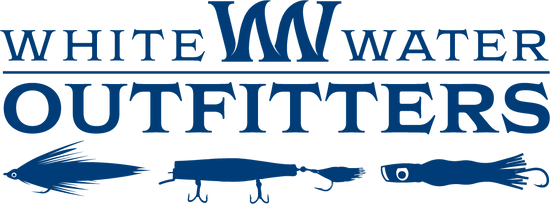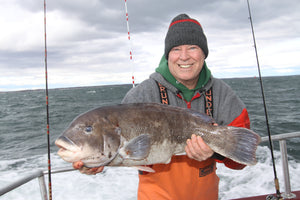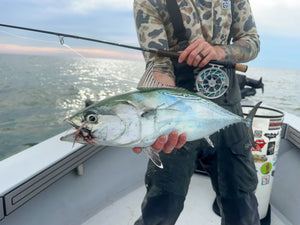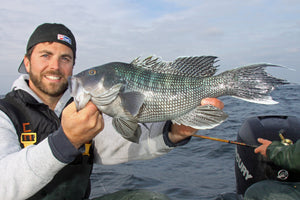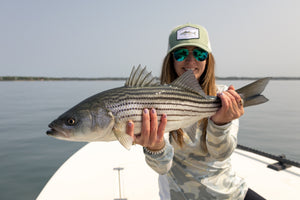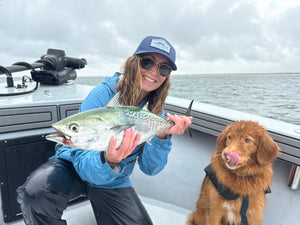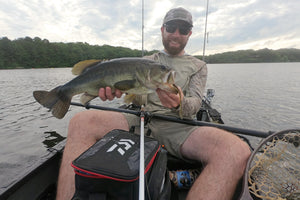Fanning Island Adventure
As sport fishing's diversity continues to expand, so does the drive of today's intrepid angler. With every passing year we are witnessing a renaissance of marine exploration reminiscent of a time long forgotten. Those with saltwater coursing deep in their veins remain lustful for the promise of untold riches in far off lands and will go through great lengths to claim them. The only difference today is that said wealth isn't stashed atop coral sands and volcanic rock of some remote island but rather swims below the azure waters lapping at their shores.

The trend toward destination travel is hardly a new concept for our modern fishing community, the burgeoning list of waypoints across the globe stretches angling opportunities to places where even imagination has yet to touch. Fortunately for our own Bryce Poyer and several friends, good fortune presented the chance to visit a little known speck of land nestled in a far-flung corner of the Pacific.
This given expedition took the band of anglers to Fanning Island, aka Tabuaeran, an infinitesimal atoll located a stone's throw to the northwest of Christmas Island within the Republic of Kiritimati. A place so remote and untouched, you could count the number of previous anglers on a couple of hands.
After four legs and seventeen hours of flight time, the group landed on Fanning yet they still had a bit more travel ahead. A World War II type landing craft was needed to collect the fishermen and their gear from Fanning's northern landing strip and carry them across its lagoon mouth to the designated lodging. It was there that the fishing team were greeted by the de facto lodging overseer Bruno de Lala. Bruno, who's become a fixture on the island arrived by a rather curious folly. A French sailor, he wrecked his sailboat on the outer reef a few decades ago and simply never left. He turned misfortune into serendipity and transformed his austere island surroundings into a personal oasis. His compound might look a little rough to some but Bruno's fondness for the place is mirrored in the name of its main guest house. He dubbed it 'A la Belle Etoile' which translates to "Under the Stars." Surrounding the house are several other Gilligan's Island style thatched roof huts that are broken down into single or double occupancy.

As one would assume, there is a rather stark lack of creature comforts at Bruno's but then again it isn't supposed to be a Sandals Resort. If you've gone this far off the grid, soaking one's toes in the pool or sipping Mai Thais from a villa should be the furthest thing from your mind. Yes, simplicity of accommodations is of no consequence to mission driven anglers. In its early stage of sport fishing infancy, the lodge is largely 'self-serve' and allows fisherman to plot their own itinerary and to be as aggressive or casual as they desired. There are three inflatable rib boats which can be used at the anglers will or with the option for a "guide" (local fisherman). Two are rigged with small fiberglass consoles and rod holders for open water fishing, while the third is tiller driven and best suited for the lagoon. With the this group being a cross of devoted flats fisherman, strict pelagic hunters, and a few dabbling at both ends of the spectrum, the three vessels afforded everyone the ability to do their thing without conflict of interest.
Four basic types of fishing are available on Fanning. Its probably best to break them down by type. We first turn to the groups breakdown of the flats scene. Given the overwhelming importance of sight casting, those choosing to fish the flats generally started their day later (i.e. 7:30-8am) when they'd have optimal sunlight and visibility. Bonefish proved to be the dominant species there but by-catch consisted of a few varieties of triggerfish and small trevallies (blue and giant). Now as far as the potential of bonefishing was concerned, Bryce describes the local population to be quite roust and very receptive to a well-placed fly. The average size fish fell into the 3-5 pound range with plenty of 6-8 pounders mixed in and even some teetering on the double digit mark. Perhaps the only frustrating aspect and limiting factor of this fishery was pattering the bones and local knowledge of tides and access through the maze of flats and coral heads.
Each flat seemed to be patrolled by a different caliber of fish and schools which could rotate territory from day to day. As most seasoned anglers are aware, tide plays a major role on where fish will be found and how they'll feed. Therein lies a major shortcoming with Fanning. Its remoteness means no standardized tide charts yet, or may ever exist. Furthermore, the island's lack of seasoned guides means a pool of local knowledge hasn't been built to the point of filing this informational void. This is being addressed at present and should be resolved for future groups. That being said there are ALOT of bonefish here, and their hungry.
Out in the blue water, pelagic species were a little easier to peg. There, wahoo in the 40-70 lb class along with yellowfin tuna to 70 lbs succumbed to a variety of offerings ranging from traditional skirted lures to trolling plugs. On the occasions when at trolling spread skimmed the barrier reef's edge, barracudas and GTs were plenty willing to charge from their craggy ambush pits and inhale anything within reach. At times it was difficult to go more than 100 yards without hooking up. The surprise of some members of the group was how close to shore the pelagics roam. At no point were any boats fishing outside the one mile mark.
By Bryce's account, reef casting was nothing short of phenomenal thanks to teaming numbers of suicidal giant trevally and a smorgasbord of voracious snapper species. He even had a couple encounters with the elusive green unicorn; the Napoleon Wrasse. Of his two Napoleon hookups, only one was successfully landed while the other chaffed off on structure. That actually brings up the most challenging aspect of plugging Fanning's various reefs. Convincing their aggressive, low pressured residents to bite is easy. Cast a popper, stickbait, or Roberts Ranger along the edge, work it properly and you will get slammed. Seeing the fish fight through to the end game, however, requires an amalgamation of skill and luck.
It doesn't take much to break your line on a sharp piece of coral. Knowing how much and when to put the heat on a fish can spell the difference in subduing jumbo GTs or not. The inflatables were so light, larger reef dwellers would tow the boat toward the reef as opposed to the angler pulling the fish from the coral. This required a designated helmsman to be quick on the throttle and back the boat away from the reef at the correct time and angle to lead the fish from the reef. A little scary considering inflatables and coral heads are a poor mix.

The last technique employed by the group was jigging along the reef drop off. Here they found a variety of grouper, jack, snapper and trevally. Butterfly jigs worked along the drop between 100-300 feet worked best. Overall the bite seemed a little challenging but hopefully with further scouting, a bottom machine and GPS hot areas can be found.
After five and a half days playing in the waters of Fanning, the group had barely begun to scratch its surface. They milked every last bit of time available and fished until noon the last day. Unfortunately, there was no escaping reality and a charter flight to Christmas Island then home was waiting.
What was their overall impressions on the experience after it was said and done? Well, there was no question in their minds that Fanning has the potential to become the next big thing. Bryce predicts that many traveling anglers will soon be adding it to the top tier of their bucket lists once more word gets out. The atoll boasts world class fishing and just a little more refinement would put it over the top. Better boats would be a major improvement on the offshore and reef fishing fronts. Once outfitted with quality electronics and bathymetric charts, narrowing down prime fishing real estate will also be a lot less daunting. Now deciphering tides and fish patterns, that all boils down to a healthy investment of time and desire which will come in due course.
With respect to life on terrafirma, rustic charm does have its place but can be crippling in other facets. Through Bruno's cuisine ranged from good to decent, food safety and potable water left something to be desired. Nearly everyone got sick at some point during the trip and either issue could have been the culprit.

If you intend on making a trip to Fanning Island, just remember to be adequately prepared. Should you discover there is something you need and don't have, the law of probability says it won't be found there. The majority of Fanning's provisions arrive by a sailing vessel which comes in three week intervals and puts a premium on essential goods.
Moral of the story, don't leave yourself at a disadvantage if avoidable. Again thought, if you're adventurous, self-sufficient, thrive on improvisation and are content with simple living, a world of untold wonder awaits you on Fanning. So consider taking a step back in time and connecting with your inner explorer. The mainstream will always be there to come home to.
- White Water Outfitters Admin
